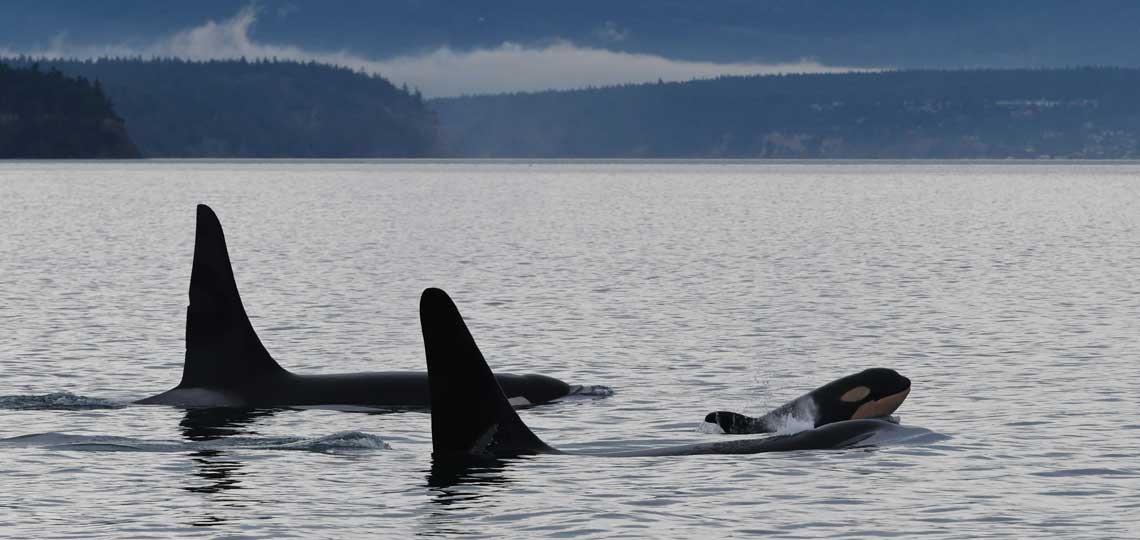2018 was a difficult year for endangered Southern Resident killer whales.
The population lost Crewser, an adult male, and Scarlet, a young female. When another calf died — so soon after its birth that it was never included in the official population count — its mother carried its body for 17 days, capturing headlines around the world.
But just a few weeks ago, there was good news. Researchers had spotted a new calf. They designated the baby orca L124 and nicknamed it “Lucky.”
I was thinking of Lucky last week, when I filed Ecojustice’s final written arguments for the National Energy Board’s (NEB) reconsideration of the Trans Mountain pipeline project.
If completed, the project would send an influx of tanker traffic through critical habitat for Lucky and its fellow Southern Residents.
More tankers would mean more underwater noise, a hazard for whales that rely on echolocation to navigate, hunt and communicate. It would also pose a physical threat. A vessel strike that kills even one whale could have population-level consequences. And an oil spill would be, in the government and NEB’s own words, “potentially catastrophic.”
On top of this, the Southern Residents are already struggling to survive existing threats, including an extreme shortage of their main food source, Chinook salmon.
A new chapter in the fight against the Trans Mountain pipeline project
Ecojustice won a major legal victory in 2018 when the Federal Court of Appeal struck down Cabinet’s approval of the Trans Mountain Expansion Project. Unfortunately, this wasn’t the end of the story.
Soon after the decision, the federal government announced two processes: New consultations with Indigenous peoples and a new NEB “reconsideration” of the project’s marine shipping impacts.
On behalf of Raincoast Conservation Foundation and Living Oceans Society, Ecojustice filed final written arguments for the NEB reconsideration on Jan. 22.
In our arguments, we told the NEB that Southern Residents already face imminent threats to their survival. Given that the status quo is already unsustainable, we wrote, the population doesn’t have the resilience to cope with more vessel traffic from the Trans Mountain project.
Ecojustice also made it clear that the law requires mitigation measures to address threats to the Southern Residents and prevent harm to the whales, destruction of critical habitat, and extinction.
Rather than putting mandatory measures in place, however, Trans Mountain wants to base its approach on future research and voluntary actions — and the NEB has already suggested it will go along with that plan. This would be tantamount to conducting an experiment in real time on a critically endangered wildlife population that already cannot deal with existing threats. This is both legally and scientifically unacceptable.
What happens next
The NEB has until Feb. 22 to review arguments and come up with a new recommendation for whether or not Cabinet should approve the Trans Mountain project for a second time.
After that, Cabinet — which has already stated that it intends to get the project built — will have up to three months to make a formal new decision.
Between the unrealistically tight NEB timelines and signals that Cabinet has already made up its mind, it’s easy to feel as though the cards are stacked against the Southern Residents. But when I saw the first photos of Lucky, trailing its mother in the choppy waters of the Pacific, I was reminded of why it’s so important that we continue to fight for this iconic population’s future.
Here at Ecojustice, we know that we can’t count on luck alone to protect the newest Southern Resident. That’s why, with the help of supporters like you, we are committed to using the power of the law to stop the Trans Mountain pipeline.
For Lucky and the 74 other remaining Southern Residents, the future depends on it.





